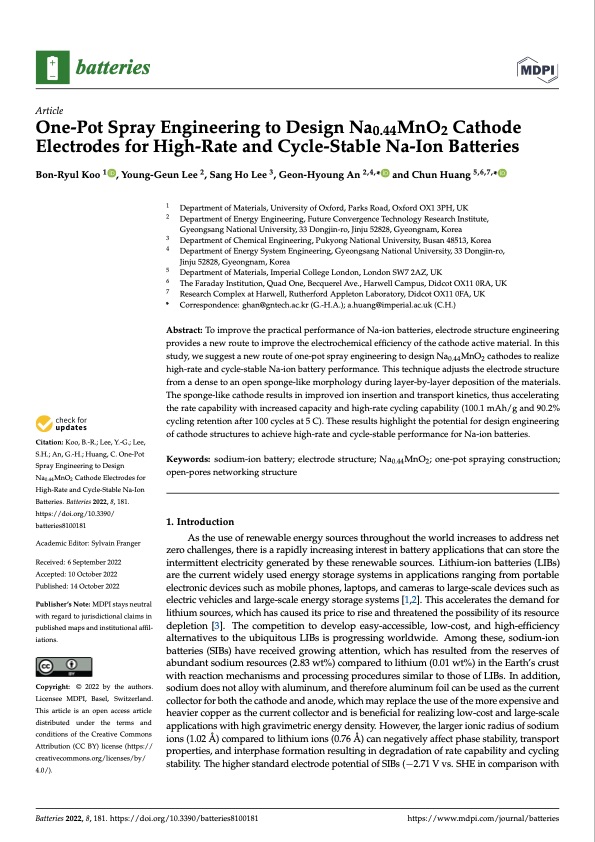
PDF Publication Title:
Text from PDF Page: 001
batteries Article One-Pot Spray Engineering to Design Na0.44MnO2 Cathode Electrodes for High-Rate and Cycle-Stable Na-Ion Batteries Bon-Ryul Koo 1 , Young-Geun Lee 2, Sang Ho Lee 3, Geon-Hyoung An 2,4,* and Chun Huang 5,6,7,* Publisher’s Note: MDPI stays neutral with regard to jurisdictional claims in published maps and institutional affil- iations. Copyright: © 2022 by the authors. Licensee MDPI, Basel, Switzerland. This article is an open access article distributed under the terms and conditions of the Creative Commons Attribution (CC BY) license (https:// creativecommons.org/licenses/by/ 4.0/). 1 2 3 4 5 6 7 * Correspondence: ghan@gntech.ac.kr (G.-H.A.); a.huang@imperial.ac.uk (C.H.) Abstract: To improve the practical performance of Na-ion batteries, electrode structure engineering provides a new route to improve the electrochemical efficiency of the cathode active material. In this study, we suggest a new route of one-pot spray engineering to design Na0.44MnO2 cathodes to realize high-rate and cycle-stable Na-ion battery performance. This technique adjusts the electrode structure from a dense to an open sponge-like morphology during layer-by-layer deposition of the materials. The sponge-like cathode results in improved ion insertion and transport kinetics, thus accelerating the rate capability with increased capacity and high-rate cycling capability (100.1 mAh/g and 90.2% cycling retention after 100 cycles at 5 C). These results highlight the potential for design engineering of cathode structures to achieve high-rate and cycle-stable performance for Na-ion batteries. Keywords: sodium-ion battery; electrode structure; Na0.44MnO2; one-pot spraying construction; open-pores networking structure 1. Introduction As the use of renewable energy sources throughout the world increases to address net zero challenges, there is a rapidly increasing interest in battery applications that can store the intermittent electricity generated by these renewable sources. Lithium-ion batteries (LIBs) are the current widely used energy storage systems in applications ranging from portable electronic devices such as mobile phones, laptops, and cameras to large-scale devices such as electric vehicles and large-scale energy storage systems [1,2]. This accelerates the demand for lithium sources, which has caused its price to rise and threatened the possibility of its resource depletion [3]. The competition to develop easy-accessible, low-cost, and high-efficiency alternatives to the ubiquitous LIBs is progressing worldwide. Among these, sodium-ion batteries (SIBs) have received growing attention, which has resulted from the reserves of abundant sodium resources (2.83 wt%) compared to lithium (0.01 wt%) in the Earth’s crust with reaction mechanisms and processing procedures similar to those of LIBs. In addition, sodium does not alloy with aluminum, and therefore aluminum foil can be used as the current collector for both the cathode and anode, which may replace the use of the more expensive and heavier copper as the current collector and is beneficial for realizing low-cost and large-scale applications with high gravimetric energy density. However, the larger ionic radius of sodium ions (1.02 Å) compared to lithium ions (0.76 Å) can negatively affect phase stability, transport properties, and interphase formation resulting in degradation of rate capability and cycling stability. The higher standard electrode potential of SIBs (−2.71 V vs. SHE in comparison with Department of Materials, University of Oxford, Parks Road, Oxford OX1 3PH, UK Department of Energy Engineering, Future Convergence Technology Research Institute, Gyeongsang National University, 33 Dongjin-ro, Jinju 52828, Gyeongnam, Korea Department of Chemical Engineering, Pukyong National University, Busan 48513, Korea Department of Energy System Engineering, Gyeongsang National University, 33 Dongjin-ro, Jinju 52828, Gyeongnam, Korea Department of Materials, Imperial College London, London SW7 2AZ, UK The Faraday Institution, Quad One, Becquerel Ave., Harwell Campus, Didcot OX11 0RA, UK Research Complex at Harwell, Rutherford Appleton Laboratory, Didcot OX11 0FA, UK Citation: Koo, B.-R.; Lee, Y.-G.; Lee, S.H.; An, G.-H.; Huang, C. One-Pot Spray Engineering to Design Na0.44MnO2 Cathode Electrodes for High-Rate and Cycle-Stable Na-Ion Batteries. Batteries 2022, 8, 181. https://doi.org/10.3390/ batteries8100181 Academic Editor: Sylvain Franger Received: 6 September 2022 Accepted: 10 October 2022 Published: 14 October 2022 Batteries 2022, 8, 181. https://doi.org/10.3390/batteries8100181 https://www.mdpi.com/journal/batteriesPDF Image | Cathode Electrodes High-Rate Cycle-Stable Na-Ion Batteries

PDF Search Title:
Cathode Electrodes High-Rate Cycle-Stable Na-Ion BatteriesOriginal File Name Searched:
batteries-08-00181-v3.pdfDIY PDF Search: Google It | Yahoo | Bing
Salgenx Redox Flow Battery Technology: Salt water flow battery technology with low cost and great energy density that can be used for power storage and thermal storage. Let us de-risk your production using our license. Our aqueous flow battery is less cost than Tesla Megapack and available faster. Redox flow battery. No membrane needed like with Vanadium, or Bromine. Salgenx flow battery
| CONTACT TEL: 608-238-6001 Email: greg@salgenx.com | RSS | AMP |